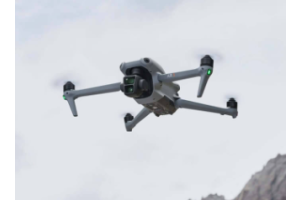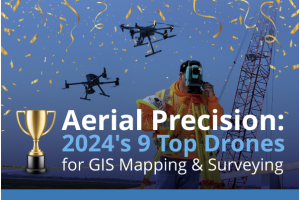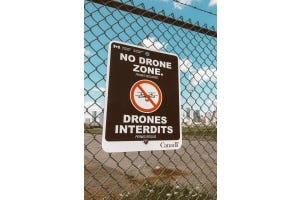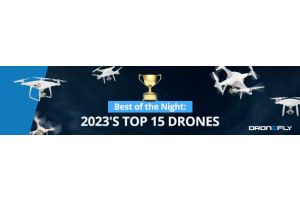
Two Powerful Surveying Tools
Drones have long been used for aerial surveying, which has proven to be one of the most popular use cases for UAS. And yet drone surveying equipment of professional quality is still rare and usually only available from specialized and expensive manufacturers.
DJI has now become one of just a few big firms to supply easily accessible mapping and aerial surveying technology with the launch of the Zenmuse P1 and Zenmuse L1 payloads for the DJI M300 RTK. Though they are much less expensive than previously available options, they are still fairly costly. The big questions, then, are the difference between the two - and are they worth it? In this article, we will tackle these topics and a couple more.
Both the Zenmuse P1 and Zenmuse L1 were released during the end of 2020. As noted earlier, these professional payloads are only compatible with the DJI M300 RTK drone. Having these products designed exclusively for DJI's flagship enterprise drone makes it clear that these payloads are aimed at the professional market. The P1, L1, and M300's higher price point compared to consumer and prosumer drones and payloads confirms this.
Though they are both aimed at the aerial surveying market, these payloads employ completely distinct mapping technologies: photogrammetry and LiDAR. With a wide range of industrial and commercial use cases, each method has its advantages and disadvantages. What the P1 and L1 both have in common is that they were created to leverage the DJI M300 drone's RTK module to increase positional accuracy. Even with limited use of Ground Control Points, this results in enormous gains in data accuracy and quality (GCPs).
According to DJI, the Zenmuse P1 and Zenmuse L1 might be game-changers in the surveying industry. They have the potential to propel the aerial surveying sector forward and make it more accessible to more individuals by offering professional mapping technologies at more appealing costs. Aerial surveying with drones could become more common with more reliable integrated solutions.
Let's take a closer look at each payload.
Getting A Closer Look
The Zenmuse P1 is a full-frame sensor mounted on a three-axis gimbal that has been specifically designed for aerial photogrammetry surveying. Photogrammetry uses a series of overlapping photographs to produce 2D or 3D models of the survey area. Each image has geolocation data incorporated, allowing it to be reconstructed in 3D space.
The low-noise sensor on the P1 can take 45 MP stills and be used with various fixed-focus lenses. The global mechanical shutter can record photos every 0.7 seconds at a maximum speed of 1/2000 second during flight. The Timesync 2.0 technology guarantees continuous synchronization at the microsecond level between the camera, GPS receiver, and numerous sensors inside the drone. The Zenmuse P1 has a horizontal accuracy of 3-cm and a vertical accuracy of 5-cm without ground control points.
The Zenmuse P1 was built for efficiency as well as accuracy. The P1 can continuously take data over a three square-kilometer region on a single battery cycle when used with the DJI M300 RTK drone. When reaching the edges of a survey region, the P1 takes only the necessary photos to save time in surveying and post-processing. The mission files are automatically saved with the applicable mission name, time, and information to make data management easier for users.
Photogrammetry is a much more basic — and likely less expensive – mapping technique than LiDAR. In reality, doing a photogrammetry survey with a non-specialized camera drone like the DJI Mavic 2 Pro isn't unheard of. As an alternative, the Zenmuse P1 provides increased productivity and accuracy, in addition to a more efficient workflow, in an all-in-one device suitable for professional use.
Despite its sophistication, the Zenmuse P1 is likely to be limited by photogrammetry technology's limits. Its reliance on visual data implies it can't be trusted in low-light situations. Shadows may obscure some elements in the survey area, especially if the area comprises major objects such as buildings and communications towers. Performing a photogrammetry survey at night or in overcast weather is another bad practice, as it typically results in data with significant inaccuracies.
The Zenmuse L1 is DJI's take on a practical LiDAR payload compatible with the DJI M300 RTK. Rather than just using a LiDAR module alone, the L1 combines a LiVox LiDAR sensor with a 20 MP RGB camera that has a 1-inch CMOS sensor. This combination is a significant advancement over traditional LiDAR technology since it allows point cloud data from the LiDAR to be layered with picture data from the CMOS sensor.
The LiVOX LiDAR module works at high speed, capturing 245,000 points per second. In addition, it has a detection range of 450 meters and boasts an accuracy of up to 5 centimeters vertically and 10 centimeters horizontally. In a single trip, it can cover up to two square kilometers, which is slightly less than the Zenmuse P1. The Zenmuse L1 sports its own high-precision IMU sensor for better positioning accuracy.
DJI designed the Zenmuse L1 to interface with Terra, a well-known drone mapping program created by DJI, the company behind the L1 and M300 drone. Besides mission planning and data processing, DJI Terra allows users to view the formation of the point cloud in real-time. Seeing problem areas will enable you to quickly make vital judgments when you're out in the field.
The most significant advantage of employing LiDAR for mapping is that data collection is not dependent on visibility. This means that a LiDAR scan can be conducted in conditions that would be difficult for photogrammetry to handle, such as at night, with severely hidden objects, or even in the rain. The Zenmuse L1 has been built with IP44 ingress protection to resist adverse weather conditions.
Which One Should I Get?
We assume that if you're interested in the Zenmuse P1 or Zenmuse L1, you're already in or planning to enter the professional aerial surveying industry. While both the L1 and P1 are fantastic, they both necessitate a high level of ability to operate well. These payload options aren't for the faint of heart.
With LiDAR mapping technology being more complicated than photogrammetry, owing to the large amount of point cloud data collected, the L1 comes in at a significantly higher price point than the P1. The L1 sells for just over $13k, while the P1 is less than half of that at $6,250.
Whether you choose photogrammetry or LiDAR, your decision on which mapping solution to purchase is based on your preferences. Photogrammetry is based on simpler concepts, but it has a significant drawback in that it relies solely on visual data. LiDAR can work in low-light conditions, although its workflow is significantly more sophisticated, reducing efficiency. If you're surveying an area with foliage, LiDAR can more efficiently penetrate the spaces between leaves and trees, albeit this capability has some limitations.
LiDAR, according to conventional belief, is more accurate than photogrammetry. However, the advancement of camera technology appears to have bridged that gap, and the difference seems to be obsolete. When comparing the precision of the Zenmuse P1 and Zenmuse L1, the use of an RTK positioning technology also helps level the playing field.
Which one to utilize is more dependent on the location of your future drone aerial surveys. Will you be doing them in a densely forested area, a desolate plain, or a crowded city? Is your survey area large enough to benefit from increased efficiency? Do you anticipate your aerial survey extending into the night, or is it so critical that you'll have to survey in gloomy or wet conditions? There are many logistical factors to take into consideration before making a decision.
In any case, purchasing either the Zenmuse P1 or the Zenmuse L1 paired with the DJI M300 RTK drone will be a hefty investment.
In Conclusion
Aerial surveying appears to be an ideal application for drones. It is, however, a highly specialized field that necessitates a high level of ability and advanced equipment. Drone payloads for aerial surveys have been challenging to come by for a long time because, up until recently, no large brands sold them.
DJI may very likely change the aerial survey sector with the Zenmuse P1 and L1 debut. DJI's market penetration could help provide sophisticated mapping technology to parts of the world where it has hitherto been difficult to obtain. Hopefully, it will also assist in lowering the cost of technology. By 2021, we want to see these new payload devices on the market.
If you need any help finding the best drone payload for needs, don't hesitate to call us, or fill out our contact form here.
Want to see another take on how the Zenmuse L1 and P1 stack against each other? Watch our video to learn more.







